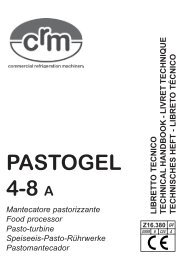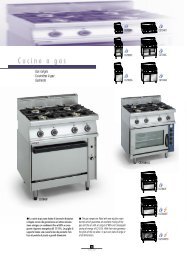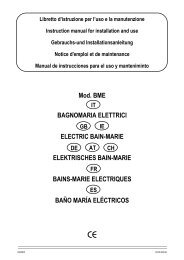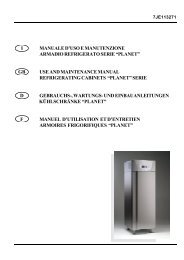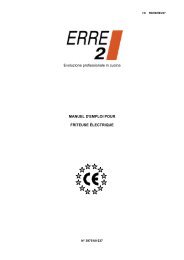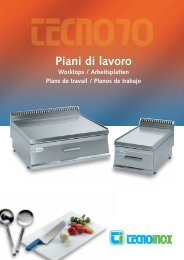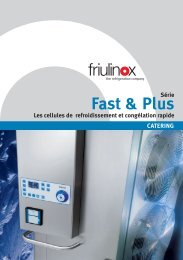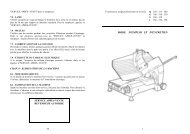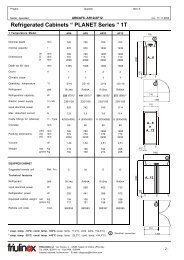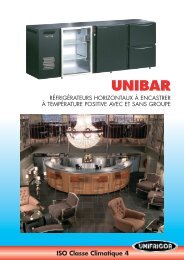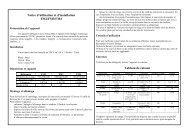convection-steam oven operating and maintenance instructions ...
convection-steam oven operating and maintenance instructions ...
convection-steam oven operating and maintenance instructions ...
You also want an ePaper? Increase the reach of your titles
YUMPU automatically turns print PDFs into web optimized ePapers that Google loves.
ISTRUZIONI PER L’UTENTE. INSTRUCTIONS FOR THE USER. ANLEITUNGEN FÜR DEN BENUTZER.<br />
NOTICE POUR L'USAGER. INSTRUCCIONES PARA EL USUARIO.<br />
COMPACT Direct combination <strong>oven</strong>s, gas <strong>and</strong> electric models, Electronic <strong>and</strong> Analogic<br />
9.1 MODALITA’ E SUGGERIMENTI PER LE COTTURE A CONVEZIONE.<br />
9.1A Cotture di primi piatti. Per cucinare lasagne, pasticci, pasta al forno, si consigliano le teglie G.N. con profondità di 45 e 60 mm., in funzione<br />
dell’altezza del prodotto. Le temperature di cottura possono variare da 160 a 180°C, mentre l’eventuale gratinatura dovrà essere eseguita a<br />
temperature superiori a 200°C.<br />
9.1B Cotture di arrosti. Per la cottura di carne, pollo e pesce utilizzare sempre le teglie G.N. la cui profondità sarà in funzione della pezzatura del<br />
prodotto. Tenere sempre presente che l’altezza del cibo non deve debordare il livello superiore della teglia. La peculiarità del sistema permette una<br />
drastica riduzione dei condimenti; sarà sufficiente ungere e insaporire gli alimenti prima di introdurli nella camera di cottura. Le temperature di cottura<br />
possono oscillare tra 150 e 180°C. e devono essere selezionate in funzione della pezzatura del prodotto. Più gr<strong>and</strong>e è la pezzatura e più bassa dovrà<br />
essere la temperatura di cottura.<br />
9.1C Cotture alla griglia. Adagiare i cibi sulle griglie in dotazione al forno dopo averli preventivamente cosparsi con una miscela di olio e aromi.<br />
Per ottenere il miglior risultato si consiglia di disporre il prodotto in modo tale che, tra i singoli pezzi, rimanga lo spazio sufficiente a permettere una<br />
ventilazione ottimale.<br />
9.1D Cotture di pasticceria. Per le cotture di prodotti che devono lievitare si consiglia l’uso di teglie con altezza di 40-60mm; viceversa per i<br />
prodotti non soggetti a lievitazione come biscotti, pasticcini etc. si possono utilizzare quelle con altezza di 20mm. Per migliorare il risultato si<br />
raccom<strong>and</strong>a di usare teglie in acciaio smaltato o in alluminio. Questi materiali, in virtù di una migliore trasmissione termica, garantiscono ottime<br />
prestazioni.<br />
9.1 TIPS FOR CONVECTION COOKING.<br />
9.1A Baking first courses. To cook lasagne <strong>and</strong> other <strong>oven</strong> baked pasta, we suggest using the 45 <strong>and</strong> 60 mm deep G.N. baking trays depending<br />
on the thickness of the product. Cooking temperatures can vary from 160 to 180°C, while temperatures above 200°C are needed for browning.<br />
9.1B Roasting meat. Always use G.N. baking trays for cooking meat, chicken <strong>and</strong> fish, the depth depending on the size of meat to cook. Always<br />
remember that the food should be no higher than the tray. With this cooking method you will need very little condiment; just grease <strong>and</strong> flavour the<br />
food before putting it in the <strong>oven</strong>. Cooking temperatures can range from 150 to 180°C <strong>and</strong> should be set according to the size of the piece of meat.<br />
The bigger it is the lower the cooking temperature.<br />
9.1C Grilling. Place the food on the grills provided with the <strong>oven</strong> after having brushed on oil <strong>and</strong> herbs for flavouring. For the best result the food<br />
should be arranged so that there is enough space between each piece to allow optimum ventilation.<br />
9.1D Bakery products. To cook food that rises we suggest using 40-60 mm high baking trays; vice versa for other products that do not rise, like<br />
biscuits, etc. the 20 mm high trays can be used. For an even better result we suggest using enamelled steel or aluminium baking trays. These<br />
materials, thanks to a better transmission of heat, guarantee excellent results.<br />
9.1 METHODEN UND RATSCHLÄGE BEIM GAREN MIT KONVEKTION.<br />
9.1A Vorspeisen. Für das Garen von Lasagne und überbackenen Nudeln wird geraten, Gastro-Norm-Behälter mit 45 oder 60mm Tiefe zu<br />
verwenden. Die Gartemperaturen können zwischen 160 und 180°C schwanken, während für das Gratinieren Temperaturen von über 200°C<br />
erforderlich sind.<br />
9.1B Braten. Für das Braten von Fleisch, Huhn und Fisch sind stets Gastro-Norm-Behälter zu verwenden, deren Tiefe von der Größe des<br />
Fleischstücks abhängt. Dabei ist darauf zu achten, dass das Gargut nicht höher sein sollte, als der obere R<strong>and</strong> des Behälters. Die Besonderheit des<br />
Systems ermöglicht eine drastische Reduzierung von Fett und Flüssigkeit: es ist ausreichend, die Speisen vor dem Hineinschieben in den Garraum<br />
einzufetten und zu würzen. Die Gartemperaturen können zwischen 150 und 180°C schwanken und müssen je nach Größe des Fleischstücks gewählt<br />
werden. Je größer das Stück ist, um so niedriger muss die Temperatur eingestellt werden.<br />
9.1C Grillen. Die Speisen auf die zur Ausstattung des Backofens gehörenden Roste legen, nachdem diese zuvor mit einer Mischung aus Öl und<br />
Würze eingestrichen wurden. Um ein gutes Ergebnis zu erzielen ist es ratsam, das Produkt auf den Rosten so zu verteilen, dass zwischen den<br />
einzelnen Stücken genügend Abst<strong>and</strong> für eine optimale Luftzirkulation bleibt.<br />
9.1D Kuchen und Gebäck. Für das Backen von Produkten, die aufgehen müssen, wird die Verwendung von Behältern mit 40-60mm Höhe<br />
angeraten, während für Produkte, die nicht aufgehen, wie Kekse und Feingebäck, Behälter mit 20mm Höhe verwendet werden können. Für ein<br />
optimales Ergebnis wird die Verwendung von emaillierten Stahlbehältern oder Behältern aus Aluminium angeraten. Diese Materialien garantieren<br />
dank ihrer großen Wärmeübertragung optimale Leistungen.<br />
9.1 MODALITÉS ET CONSEILS POUR LES CUISSONS À CONVECTION.<br />
9.1A Cuissons de pâtes. Pour cuisiner des lasagnes, des gratins ou des pâtes au four, nous conseillons d'utiliser des bacs G.N. de 45 et 60 mm de<br />
profondeur, en fonction de la hauteur des aliments. Les températures de cuisson peuvent varier de 160 à 180°C, t<strong>and</strong>is que pour gratiner, il faudra<br />
mettre le four à plus de 200°C.<br />
9.1B Cuissons des rôtis. Pour cuisiner de la vi<strong>and</strong>e, du poulet, du poisson, nous conseillons d’utiliser toujours les bacs G.N. ayant une profondeur<br />
adéquate à la grosseur de l'aliment. Faire attention à ce que l’aliment ne déborde pas du bac. Ce système a la particularité de réduire au minimum les<br />
assaisonnements. Il suffira d'huiler et d’épicer les aliments avant de les mettre au four. Les températures de cuisson peuvent varier entre 150° et<br />
180°C et elles devront être choisies en fonction de la grosseur de l'aliment, en sachant que plus celui-ci est gros, plus la température de cuisson doit<br />
être basse.<br />
9.1C Cuisson au grill. Disposer les aliments préalablement assaisonnés avec de l’huile et des arômes sur les grilles fournies avec le four. Pour<br />
obtenir de très bons résultats de cuisson, laisser assez d’espace entre les aliments afin que l’air puisse circuler suffisamment et permettre une<br />
ventilation parfaite.<br />
9.1D Cuissons des pâtisseries. Pour cuire des pâtisseries qui doivent lever, nous conseillons d’utiliser des bacs de 40 à 60 mm de profondeur;<br />
t<strong>and</strong>is que pour celles qui n’en ont pas besoin, comme par exemple les biscuits, les petits fours, etc., utiliser des bacs de 20 mm de profondeur. Pour<br />
obtenir un meilleur résultat, il est préférable d’utiliser des bacs en acier émaillé ou en aluminium. Ces matériaux, ayant la propriété de transmettre la<br />
chaleur, garantissent des performances optimales.<br />
30



